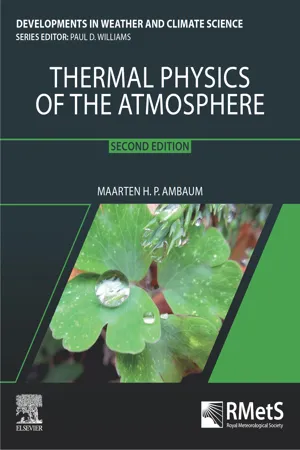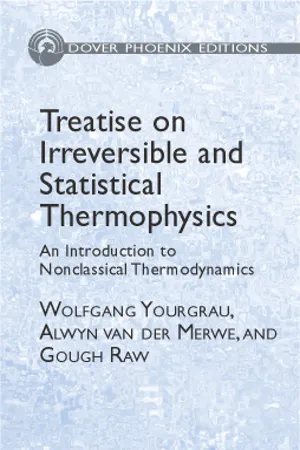Physics
Non-Flow Processes
Non-flow processes in physics refer to systems where the properties of the substance within the system change with time and are not uniform throughout. This can include processes such as heating or cooling, chemical reactions, or phase changes. Non-flow processes are characterized by the absence of steady-state conditions and involve changes in the system's internal energy and entropy.
Written by Perlego with AI-assistance
Related key terms
5 Key excerpts on "Non-Flow Processes"
- eBook - ePub
- James Luscombe(Author)
- 2018(Publication Date)
- CRC Press(Publisher)
We’ll be guided by the use of balance equations, integral equations which account for the change, in time, in the amount of a quantity in a region of space. The equations of hydrodynamics follow from balance equations for mass, energy, and momentum, as we’ll show. We’ll establish a balance equation for entropy, where changes in entropy are controlled by the flow of mass, energy and momentum, and by the generation of entropy by irreversible processes. One of the goals of non-equilibrium thermodynamics is to identify the role of inhomogeneities in contributing to entropy creation. 14.1 Non-equilibrium processes Basic flow processes are described by phenomenological equations expressing a proportionality between fluxes and gradients. Familiar examples are Fourier’s law, a proportionality between heat flux J Q (units of W m - 2) and a temperature gradient, J Q = - κ ∇ T, where κ is the thermal conductivity (W K - 1 m - 1); Fick’s law, between a particle flux J n (m - 2 s - 1) and a concentration gradient, J n = - D ∇ n, where D is the diffusion coefficient (m 2 s - 1), and n is the particle density, number of particles per volume; Ohm’s law, between the electric current density J q (A m - 2) and the gradient of the electrostatic. potential, ϕ, J q = - σ ∇ ϕ, where σ is the electrical conductivity (S m - 1); and Newton’s law of viscosity, that the shear stress T xy (Pa) between adjacent layers in a fluid is proportional to a gradient of the velocity field, T xy = - ν ∂ v x / ∂ y, where ν is the viscosity (Pa s). These relations are summarized in Table 14.1. Table 14.1 Gradient-driven fluxes More complex phenomena arise when two or more of these basic effects are present simultaneously. In thermoelectricity, electrical conduction and heat conduction occur together. When a temperature gradient is set up, not only does heat flow but an electric field is created - eBook - ePub
- Maarten H.P. Ambaum(Author)
- 2020(Publication Date)
- Royal Meteorological Society – Elsevier(Publisher)
Chapter 11: Non-equilibrium processes
Abstract
For individual, homogeneous volumes of a substance, gas or liquid, in local thermodynamic equilibrium, we can apply, by definition, the machinery of equilibrium thermodynamics. The majority of processes described in this book fall under this heading. When the substance is non-homogeneous, it is not in thermodynamic equilibrium and we need to consider non-equilibrium processes. Clearly, the atmosphere as a whole is profoundly non-homogeneous.The signature of non-equilibrium thermodynamics is the irreversible increase of entropy in a system. The task at hand is to ascribe the irreversible increase of entropy to specific physical processes.For an individual homogeneous parcel we can still describe reversible entropy changing (diabatic) processes as they result from heat exchange with its environment. Irreversible entropy change only occurs when the full non-homogeneous system is considered.Keywords
non-equilibrium thermodynamics; lost work; Guoy–Stodola theorem; climate thermodynamics; maximum entropy productionFor individual, homogeneous volumes of a substance, gas or liquid, in local thermodynamic equilibrium, we can apply, by definition, the machinery of equilibrium thermodynamics. The majority of processes described in this book fall under this heading. When the substance is non-homogeneous, it is not in thermodynamic equilibrium and we need to consider non-equilibrium processes. Clearly, the atmosphere as a whole is profoundly non-homogeneous.The signature of non-equilibrium thermodynamics is the irreversible increase of entropy in a system. The task at hand is to ascribe the irreversible increase of entropy to specific physical processes.For an individual homogeneous parcel we can still describe reversible entropy changing (diabatic) processes as they result from heat exchange with its environment. Irreversible entropy change only occurs when the full non-homogeneous system is considered. - eBook - ePub
- Nils O. Petersen(Author)
- 2017(Publication Date)
- CRC Press(Publisher)
The path whereby a change of state occurs can be restricted such that one of the key state functions remains constant throughout the process. This is useful conceptually as well as experimentally, since it allows for controlled changes in state during which the number of variables is reduced. Some common processes are:Figure 6.1: Schematic illustrations of isolated, closed, and open systems.- isothermal processes in which the temperature of the system is held constant,
- isobaric processes in which the pressure of the system is held constant,
- isochoric processes in which the volume of the system is held constant,
- isentropic processes in which the entropy (see later) of the system is held constant, and
- adiabatic processes in which there is no heat flow to or from the system.
Isothermal processes require that our system is in a large bath held at constant temperature that can transfer heat to or from the system in order to keep the temperature constant. Isobaric processes are typically those that occur in a container that can change volume to allow the internal pressure to always equilibrate with the external pressure. Open systems usually allow for isobaric processes. Isochoric processes occur in containers that cannot expand or contract so that there is no relationship between the external and internal pressure. Isentropic processes will be described later when we have defined the concept of entropy, but are generally more difficult to design. Adiabatic processes require that there is no heat flow to or from the system, but energy can still be exchanged in terms of work, so pressure, volume, and temperature can all change. This could happen in a thermos with a piston, or will happen in very fast processes where there is no time to exchange heat, such as the expansion of a gas that escapes from a balloon.The process whereby a change in state occurs can be reversible or irreversible - eBook - ePub
Treatise on Irreversible and Statistical Thermodynamics
An Introduction to Nonclassical Thermodynamics
- Wolfgang Yourgrau, Alwyn van der Merwe, Gough Raw(Authors)
- 2013(Publication Date)
- Dover Publications(Publisher)
Yet it would be a serious error to assume that irreversible phenomena without exception are outside the range of adequate presentation. In fact, a number of irreversible changes easily come to mind, which are so lacking in complexity that an adequacy of description can be realized. Here are some illustrations: the conduction of heat along a metal bar whose ends are kept at fixed but different temperatures; the development of Joule heat when an electric current flows through a metallic conductor; diffusion of a solid or fluid across a concentration gradient; laminar flow of a viscous fluid; and so on. All these simple processes can be characterized with the aid of a few parameters such that, once their values are specified, all measurable aspects become predictable. Thus the heat passing from one end of a homogeneous, laterally insulated metal bar at temperature T 1 to its other end at the temperature T 2, will always be proportional to (1/ L)(T 1 - T 2), L being the length of the bar. Again, an electric current I flowing through an ohmic resistance R will without fail develop I 2 R units of heat per unit time. After these preliminary remarks, it is clear that in traditional thermodynamics one only scouts around the periphery of the total area that should be open to thermophysical attack. To elaborate this assertion, we distinguish between the detailed and the overall treatments of physical processes. A detailed discussion deals with quantitative statements about every step of a process, whereas in an overall approach one is content to restrict all quantitative assertions to the process as a whole. The essential limitation of classical thermodynamics may now be expressed by saying that it attains detailed descriptions only for a very special kind of changes—namely, reversible processes - Daniel E. Rosner(Author)
- 2012(Publication Date)
- Dover Publications(Publisher)
1 Introduction to Transport Processes in Chemically Reactive Systems INTRODUCTION The information needed to design and control engineering devices for carrying out chemical reactions will be seen below to extend well beyond the obviously relevant underlying sciences of: i. thermochemistry/stoichiometry, and ii. chemical kinetics, already encountered in each student’s preparatory courses. Even the basic data of these underlying sciences are generated by using idealized laboratory configurations (e.g., closed calorimeters (“bombs”), well-stirred reactors, etc.) bearing little outward resemblance to practical chemical reactors. This book deals with the role, in chemically reacting flow systems, of transport processes —particularly the transport of momentum, energy, and (chemical species) mass in fluids (gases and liquids). The laws governing such transport will be seen to influence: i. the local rates at which reactants encounter one another; ii. the ability of the reactants to be raised to a temperature at which the rates of the essential chemical reactions are appreciable; iii. the volume (or area) required to carry out the ensuing chemical reaction(s) at the desired rate; and iv. the amount and the fate of unwanted (by-) products (e.g., pollutants) produced. For systems in which only physical changes occur (e.g., energy and/or mass exchange, perhaps accompanied by phase change), the same general principles can be used to design (e.g., size) or analyze equipment, usually with considerable simplifications. Indeed, we will show that the transport laws governing nonreactive systems can often be used to make rational predictions of the behavior of “analogous” chemically reacting systems
Index pages curate the most relevant extracts from our library of academic textbooks. They’ve been created using an in-house natural language model (NLM), each adding context and meaning to key research topics.




